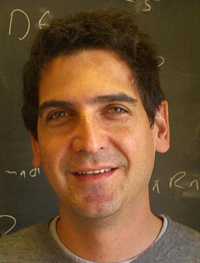In the third year of the Early Career Research Program managed by the U.S. Department of Energy’s Office of Science, five researchers at Lawrence Berkeley National Laboratory (Berkeley Lab) were on the list of 68 recipients from 47 institutions announced earlier this week.
The awards focus on areas of high priority for the nation and for DOE’s mission, supporting exceptional researchers during the critical stages of their formative work by funding their research for up to five years and $2.5 million. The grants are administered by the major program offices within the Office of Science.
Berkeley Lab’s winners are:
 Hank Childs of the Computational Research Division’s Visualization Group and the Department of Computer Science at the University of California at Davis.
Hank Childs of the Computational Research Division’s Visualization Group and the Department of Computer Science at the University of California at Davis.
Childs is the architect of VisIt, one of the most popular frameworks for data analysis and scientific visualization. He joined Berkeley Lab in 2009 after nearly a decade in Lawrence Livermore National Laboratory’s Advanced Simulation and Computing program, where he was a member of the original VisIt development team. He continues to enhance VisIt for the petascale visualization and analysis needs of researchers in the Department of Energy’s Office of Science. Child’s Early Career Award for “Data Exploration at the Exascale” from the Office of Advanced Scientific Computing Research furthers this research.
 John Dueber of the Physical Biosciences Division, UC Berkeley College of Engineering, and the Energy Biosciences Institute.
John Dueber of the Physical Biosciences Division, UC Berkeley College of Engineering, and the Energy Biosciences Institute.
A bioengineer who uses the tools of synthetic biology to engineer microbes for producing liquid transportation fuels from plant biomass, one of Dueber’s major efforts is to improve the efficiency of xylose catabolism in the common yeast Saccharomyces cerevisiae. Xylose is the major constituent of hemicellulose, an attractive but so far untapped feedstock sugar for fuel. Dueber and his group pursue a combination of strategies including optimizing the expression of crucial enzymes, by screening a library of promising promoters, and addressing bottlenecks at the protein level, by designing synthetic scaffolds to co-localize enzymes for increased efficiency and limited loss, which will improve xylose import. Dueber’s Early Career Award is for Repurposing the Saccharomyces Cerevisiae Peroxisome for Compartmentalizing Multi-Enzyme Pathways is from the Office of Basic Energy Sciences.
 Oliver Gessner of the Ultrafast X-Ray Science Laboratory Chemical Sciences Division in the Chemical Sciences Division.
Oliver Gessner of the Ultrafast X-Ray Science Laboratory Chemical Sciences Division in the Chemical Sciences Division.
In 2010 Gessner led the Berkeley Lab contingent of a multi-institutional team that published the very first research results from SLAC National Laboratory’s LCLS, the Linac Coherent Light Source, detailing their counterintuitive discovery that as x-ray pulses impacting nitrogen molecules grow shorter and more powerful, they do less damage, not more. He continues his research with x-ray pulses measured in femtoseconds, including recent work to figure out why coating semiconductors with dye molecules to help them absorb a broad spectrum of sunlight and convert it into electrical current has so far lagged behind its early promise of cheap, efficient solar cells. Gessner’s Early Career Award for Ultrafast X‐ray Studies of Intramolecular and Interfacial Charge Migration, from the Office of Basic Energy Sciences, will examine this and related questions.
 Daniel Kasen of the Nuclear Science Division and the Department of Physics at the University of California at Berkeley.
Daniel Kasen of the Nuclear Science Division and the Department of Physics at the University of California at Berkeley.
Starting as a graduate student in Berkeley Lab’s Computational Research Division, Kasen has concentrated on applying high-performance computing and simulation to further our understanding of supernovae and other stellar explosions. The nucleosynthesis that occurs under extreme conditions inside supernova explosions has produced the majority of the heavier elements in the periodic table. Although they account for only a minor part of the universe’s total mass, these elements make life and its environs possible. Kasen’s Early Career Award for Modeling Astrophysical Explosions and the Nucleosynthesis of the Heavy Elements, from the Office of Nuclear Physics, will continue this research, improving our understanding of photon and neutrino physics within explosive astrophysical environments and further developing and applying advanced simulation codes to address fundamental questions in nuclear astrophysics.
 Kevin Wilson, of the Chemical Dynamics Beamline in the Chemical Sciences Division.
Kevin Wilson, of the Chemical Dynamics Beamline in the Chemical Sciences Division.
Wilson investigates surface reactions of free radicals at organic interfaces with relevance for environmental, atmospheric aerosol and cloud chemistry. His award from the Office of Basic Energy Sciences is for his proposal entitled, “Free Radical Reactions of Hydrocarbons at Aqueous Interfaces.”
Fiscal year 2012 marks the third year of a planned annual program of research awards from the Office of Science. This year’s winners were chosen based on peer review by outside scientists unaffiliated with DOE, who considered over 850 proposals submitted last fall. For more information, see DOE’s announcement at http://science.energy.gov/early-career/
###
DOE’s Office of Science is the single largest supporter of basic research in the physical sciences in the United States, and is working to address some of the most pressing challenges of our time. For more information, please visit science.energy.gov/.
Lawrence Berkeley National Laboratory addresses the world’s most urgent scientific challenges by advancing sustainable energy, protecting human health, creating new materials, and revealing the origin and fate of the universe. Founded in 1931, Berkeley Lab’s scientific expertise has been recognized with 13 Nobel prizes. The University of California manages Berkeley Lab for the U.S. Department of Energy’s Office of Science. For more, visit www.lbl.gov/.